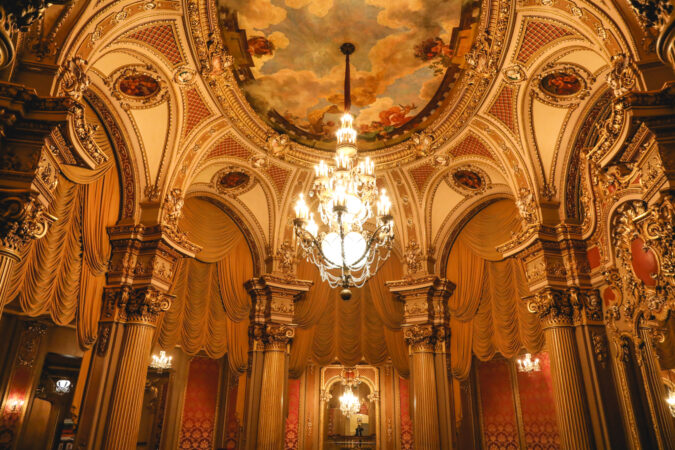The Broadway theater district is the world’s most popular space for commercial stage entertainment. Its history dates back to the mid-19th century, although Thomas Keane and Walter Murray are credited with opening the first major theater in New York in 1750. Today, the theater district spans a large area between 41st and 53rd streets in Manhattan and includes 41 theaters, including the Ambassador Theatre, Ethel Barrymore Theatre, George Gershwin Theatre, and Hayes Theatre.
Several different venues have served as Broadway theaters over the past 150 years. Many of these have been demolished or repurposed. Below is a look at five notable venues that once housed Broadway plays and musicals.
Mark Hellinger Theatre
Located between Eighth Avenue and Broadway at 237 West 51st Street, the Mark Hellinger Theatre was a movie theater when it opened in 1930 but also had a large stage to accommodate live musical shows between film screenings. Designed by famed architect Thomas W. Lamb, the building later exclusively showed live stage performances and was known as the 51st Street Theatre and the Hollywood Theatre before being named in honor of theater journalist Mark Hellinger in 1949. Its interior is decorated in a lavish Baroque style, with ceilings covered in murals, while the façade has a more modern design.
The theater housed original productions such as My Fair Lady (1956), On a Clear Day You Can See Forever (1965) and Jesus Christ Superstar (1971). The Times Square Church leased the building in 1989 and purchased it two years later. Despite the change in ownership, much of the interior remains the same from when the building was a Broadway theater.
Castle Garden
Castle Garden was one of the earliest Broadway venues, although it didn’t function as a theater for very long. The building was constructed in 1808 as Fort Clinton, a round brick edifice on a tiny island adjacent to the shoreline of Battery Park. The US military abandoned the fort in 1824, following which the building was transformed into an indoor garden. The building was renovated once again in 1839 as a concert venue and became known as Castle Garden in 1847.
The venue functioned as an opera house for a five-year period, during which time it hosted the New York debut of Jenny Lind, a renowned Swedish opera singer known as the “Swedish Nightingale.” It later served as an immigrant processing center for several decades until it became an aquarium in 1895. It is now an open-air visitor center for the Statue of Liberty.
Hammerstein’s Theatre
Now known as the Ed Sullivan Theater, the iconic building at 1697 Broadway was built by Arthur Hammerstein in 1927 and named in honor of his father, Oscar. Listed on the U.S. Register of Historic Places, the theater features a brick and terracotta façade and, uncommon for the era, a neo-Gothic interior that resembles a cathedral. Hammerstein’s Theatre hosted productions such as Golden Dawn (1927), Sweet Adeline (1929), Luana (1930), and Murder in the Cathedral (1936). The theater also functioned as a nightclub during the early 1930s and, since 1936, has been used by CBS as a radio and TV studio.
Renamed CBS-TV Studio 50 in 1950, it hosted live telecasts of The Ed Sullivan Show, The Jackie Gleason Show, The Merv Griffin Show, and many different game shows. The Beatles made their US debut at the venue on The Ed Sullivan Show in 1964. The Late Show with David Letterman was shot at the venue from 1993 to 2015. Today, the Ed Sullivan Theater is the home of The Late Show with Stephen Colbert.
Republic Theatre
Oscar Hammerstein built the Republic Theatre, which opened in 1900 and hosted stage productions for three decades until it was transformed into Broadway’s first Burlesque house. Its most notable tenant was Abie’s Irish Rose, which ran from 1922 to 1927 and is among the longest-running plays in Broadway history. It became a movie theater in 1942 and infamously showed pornographic films during the 1970s.
Now an off-Broadway venue known as the New Victory Theater, the building represents New York’s oldest operating theater. The nonprofit organization New 42nd Street, in partnership with New York City, bought the venue in 1990 and reopened it five years later, returning it to its roots as a commercial stage entertainment space.
Times Square Theater
Near the American Airlines Theatre, westward bound on the north side of 42nd Street between Broadway and Eighth Avenue, stands tall the majestic columns of the former Times Square Theater. The now vacant building is a historic Broadway landmark that functioned strictly as a live theater space from its opening in 1920 until 1934, when it was transformed into a movie theater. It housed original productions such as The Front Page (1928), Strike Up the Band (1930), and Private Lives (1931).
The Times Square Theater continued to show films until it closed during the 1990s. While it was purchased by The New 42nd Street nonprofit in 1990, none of the proposed redevelopment plans have come to fruition. One of the proposed plans was to have the venue host a 4D film experience showcasing the history of Broadway. This was originally announced in 2012 but stalled two years later after due to financial troubles. In 2017, Stillman Development International LLC leased the theater, signing a 73-year agreement and intending to renovate the building. Although Stillman executives said in 2019 that the renovation might take two years, the project is still incomplete.

